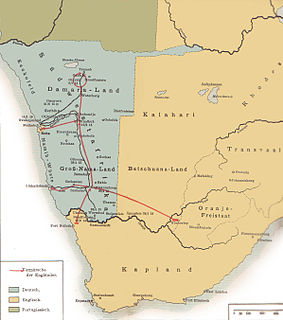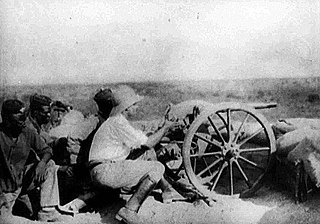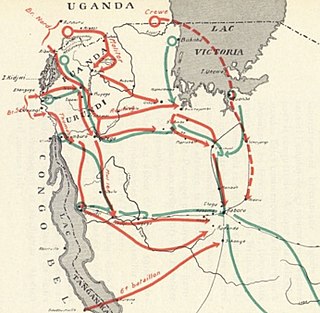
The South West Africa campaign was the conquest and occupation of German South West Africa by forces from the Union of South Africa acting on behalf of the British imperial government at the beginning of the First World War.

Kamerun was an African colony of the German Empire from 1884 to 1916 in the region of today's Republic of Cameroon. Kamerun also included northern parts of Gabon and the Congo with western parts of the Central African Republic, southwestern parts of Chad and far eastern parts of Nigeria.

The African Theatre of the First World War comprises campaigns in North Africa instigated by the German and Ottoman empires, local rebellions against European colonial rule and Allied campaigns against the German colonies of Kamerun, Togoland, German South West Africa and German East Africa. The campaigns were fought by German Schutztruppe, local resistance movements and forces of the British Empire, France, Italy, Belgium and Portugal.

The East African campaign in World War I was a series of battles and guerrilla actions, which started in German East Africa (GEA) and spread to portions of Portuguese Mozambique, Northern Rhodesia, British East Africa, the Uganda Protectorate, and the Belgian Congo. The campaign all but ended in German East Africa in November 1917 when the Germans entered Portuguese Mozambique and continued the campaign living off Portuguese supplies.
The Battle of Kisaki was a confrontation between German and South Africa forces near the town of Kisaki, German East Africa, on 7–11 September 1916.

The Togoland Campaign was a French and British invasion of the German colony of Togoland in West Africa, which began the West African Campaign of the First World War. German colonial forces withdrew from the capital Lomé and the coastal province to fight delaying actions on the route north to Kamina, where the Kamina Funkstation linked the government in Berlin to Togoland, the Atlantic and South America.

The Kamerun campaign took place in the German colony of Kamerun in the African theatre of the First World War when the British, French and Belgians invaded the German colony from August 1914 to March 1916. Most of the campaign took place in Kamerun but skirmishes also broke out in British Nigeria. By the Spring of 1916, following Allied victories, the majority of German troops and the civil administration fled to the neighbouring neutral colony of Spanish Guinea. The campaign ended in a defeat for Germany and the partition of its former colony between France and Britain.

The First Battle of Garua took place from 29 to 31 August 1914 during the Kamerun Campaign of the First World War between German and invading British forces in northern Kamerun at Garua. It was the first significant action to take place in the campaign and resulted in the German repulsion of the British force.
The Battle of Jabassi or Battle of Yabassi was a pair of assaults on German positions at Jabassi on the Wuri river during the Kamerun Campaign of World War I between German and British forces on 7 and 14 October 1914. The action resulted in British victory and their occupation of the station.
The Battle of Nsanakong or Battle of Nsanakang took place between defending British and attacking German forces during the Kamerun Campaign of the First World War. The town of Nsanakong had been occupied by the British on 30 August 1914. On 6 September, German forces attacked, driving the British force over the border back into Nigeria.
The Siege of Mora or Siege of Moraberg, between Allied and besieged German troops, took place from August 1914 to February 1916 on and around the Mora mountain in northern Kamerun during the Kamerun Campaign of the First World War. After more than a year of siege German forces on the mountain surrendered, following the escape of many German troops to the neutral Spanish colony of Río Muni. It was the longest siege of the war.
The Battle of Kusseri between German and French forces took place from late August to 25 September 1914 in Kusseri, northeastern Kamerun during the Kamerun Campaign of World War I. The action resulted in the French capture of the Kusseri fort and the German garrison's retreat to Mora.

The Second Battle of Garua took place from 31 May to 10 June 1915 during the Kamerun campaign of the First World War in Garua, German Kamerun. The battle was between a combined French and British force and defending German garrison and resulted in an Allied victory.
The Battle of Ngaundere or Battle of Ngaoundéré was a small engagement fought between German and British forces on 29 July 1915 during the Kamerun campaign of World War I. It resulted in a German defeat and British occupation of the town.
During the Battle of Banjo or Battle of Banyo, British forces besieged German forces entrenched on the Banjo mountain from 4 to 6 November 1915 during the Kamerun campaign of the First World War. By 6 November much of the German force had deserted, while the rest surrendered. The battle resulted in victory for the Allies and breakdown of German resistance in northern Kamerun.
The Second Battle of Edea was the German counter-attack against French forces stationed in the village of Edea during the Kamerun Campaign of the First World War. Allied forces from Duala occupied the town following the First Battle of Edea in October 1914. The Germans, eager to retake the position attacked on 5 January 1915 but were repulsed by the French force.
The Second Battle of Jaunde involved the successful British and French assault on the German capital of Jaunde during the Kamerun Campaign of the First World War. After the failure of the First Battle of Jaunde during the summer of 1915, the bulk of Allied forces had retreated to the Kele river. Following the Second Duala Conference where Allied commanders discussed the situation, it was decided that another assault should be attempted. Although the columns surrounding Jaunde were not in effective communication with one another, on 1 January 1916, British forces under Colonel Georges occupied the capital. By this time it had been abandoned by the German troops who had fled to the neutral Spanish colony of Río Muni. This Allied victory signaled the end of German resistance in Kamerun apart from the Siege of Mora which would continue for another few months.
The First Battle of Edea involved the British and French assault on German forces stationed in the village of Edea during the Kamerun Campaign of the First World War. Allied forces from Duala launched their advance on 20 October. Following stiff resistance along the southern railway line between Duala and Edea, German forces withdrew from the town to Jaunde, allowing Allied troops to finally occupy Edea on 26 October 1914.

The Tabora Offensive was an Anglo-Belgian offensive into German East Africa, which ended with the Battle of Tabora in the north-west of German East Africa, it was part of the East African Campaign in World War I. The forces of the Belgian Congo crossed the border with German East Africa and captured the port city of Kigoma and the city of Tabora. In August a smaller Lake Force under the command of the South African brigadier general Crewe, launched a parallel attack from Uganda, also aimed at taking Tabora. The completion of the Tabora Offensive not only left much of the Ruanda-Urundi territory under Belgian military occupation but gave the Allies control of the important Tanganjikabahn railway.

Ernst Klaus Iwan Christian Friedrich Alfred von Raben was a German Major who had served as a commander of the Schutztruppe before surrendering at the Siege of Mora.



















